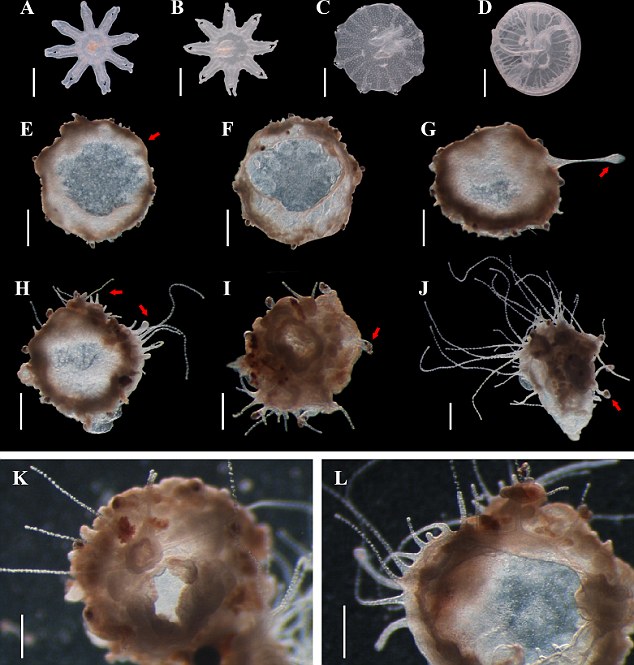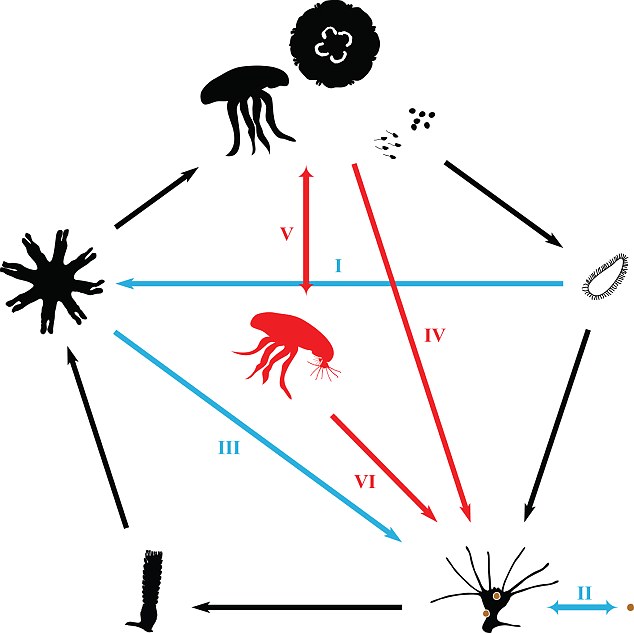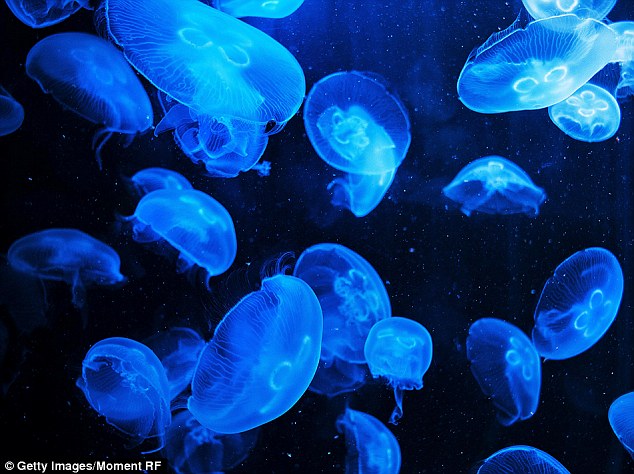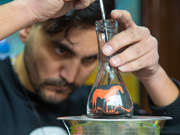

The common moon jellyfish is anything but ordinary.
These incredible creatures can grow new limbs, rearrange their entire body structure and even create clones of themselves.
And recent research has revealed that moon jellies have a Benjamin Button-like ability to age backwards.

Recent research has revealed that moon jellies have a Benjamin Button-like ability to age backwards. A-D shows the normal development from ephyrae to juvenile medusae. E and F show a 25-day old medusa. G-L: juvenile medusae during so-called 'reverse transformation'.
The discovery was made by Jinru He, a graduate student in marine biology at China's Xiamen University, according to an in-depth report in National Geographic.
Several years ago, he picked up a baby male moon jellyfish from the ocean and raised it until it was a full grown adult.
Jinru placed the corpse of the dead jellyfish into a new tank and three months later, a polyp appeared on the specimen.
When an adult jellyfish – also known as a medusa - is injured it moves to the bottom of the ocean floor.

When an adult jellyfish – also known as a medusa - is injured it moves to the bottom of the ocean floor. When it's there, it transforms back into its infant state, known as a polyp. Normal development traits and stages of a jellyfish are shown in black, while the red illustraiton reveals what was observed in the latest study.
It then transforms back into its infant state, known as a polyp, which then forms back into a medusa.
Most jellyfish start life as buds off polyps on the ocean floor or a coral reef. But the creation of a polyp in this way had never been seen before.
National Geographic said that what Jinru observed was similar to a piece of butterfly wing sprouting a caterpillar.
The pulps grew into medusa jellyfish, and then instead of dying, transformed again to a younger pulp stage.
'The present study describes the unprecedented potential of life cycle reversal in Aurelia by showing that the polyp stage can be achieved directly from both juvenile and sexually mature medusae,' He wrote in a paper.
He also noticed that in some medusae, polyps grew outside those tears in their mouths. Those polyps then formed into clones of the jellyfish.
Scientists believe that understanding how jellyfish can achieve this could hold the give to living longer.
Last year, researchers at Caltech discovered that when moon jellyfish lose limbs, they don't regrow them. Instead, they re-organise their bodies to stay symmetrical.
This so-called resymmetrisation occurred whether the animal had as few as two limbs remaining or as many as seven.
'Jellyfish move by "flapping" their arms; this allows for propulsion through the water, which also moves water - and food - past the mouth,' he says.
'As they are swimming, a boundary layer of viscous - that is, thick - fluid forms between their arms, creating a continuous paddling surface.
'And you can imagine how this paddling surface would be disturbed if you have a big gap between the arms.'
Maintaining symmetry appears to be vital not just for propulsion and feeding, the researchers found.
In the few cases when the injured animals do not rearrange their body parts—only about 15 per cent of the injured animals they studied—the unsymmetrical juvenile also cannot develop into normal adult jellyfish.

Last year, researchers at Caltech discovered that when moon jellyfish lose limbs, they don't regrow them. Instead, they re-organise their bodies to stay symmetrical. Scientists believe that understanding how jellyfish can achieve this could hold the give to living longer.
Day|Week

 Qiandaohu supply ship named 'model ship' by PLA Navy
Qiandaohu supply ship named 'model ship' by PLA Navy Stunning Kuche on the Silk Road
Stunning Kuche on the Silk Road Tunisian man creates art of sand in Hangzhou
Tunisian man creates art of sand in Hangzhou Goddess teacher shares fitness program online
Goddess teacher shares fitness program online Getting close to PLA's easternmost post on the mainland
Getting close to PLA's easternmost post on the mainland 'Naked run' race held in Beijing
'Naked run' race held in Beijing Train Attendant Recruitment Held in East China
Train Attendant Recruitment Held in East China In pics: Russia's Su-35 fighter jets
In pics: Russia's Su-35 fighter jets Young monks learn kungfu in NE China temple
Young monks learn kungfu in NE China temple Scenery of Guzhu, thousand-year-old ancient village in E China
Scenery of Guzhu, thousand-year-old ancient village in E China